|
Neelin
Like Glenora, Neelin, the town, didn’t make an appearance until the
arrival the Wakopa Line. From Glenora the rails skirted the north shore
of Rock Lake in search of a suitable place to cross the deep valley
between Rock Lake and Lake Louise. It found such a place on 19-3-14 a
site that Joseph Neelin had recently purchased and a town was born.
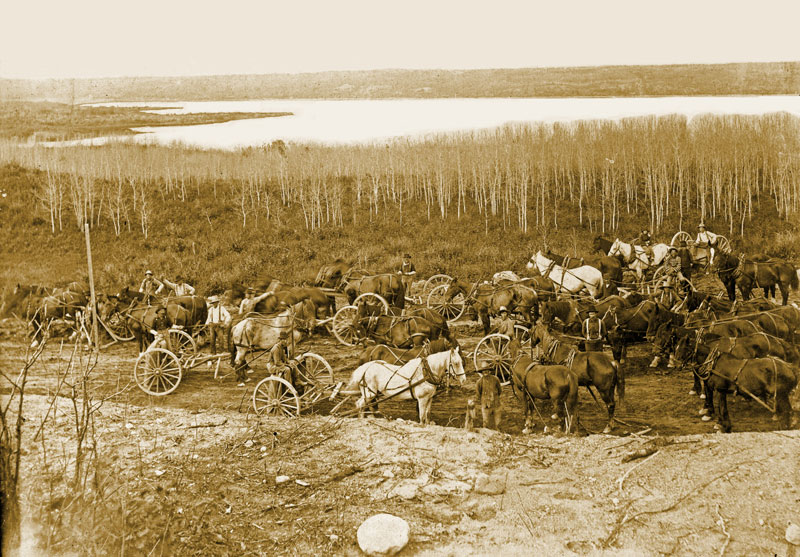
Grading the line near Neelin. (McKee Archives)
The community had been there quite a while. Mr. Neelin had settled just
east of the future town site in 1881. John Cumming, former soldier and
ship’s captain, who first came to the Marringhurst area in 1879 had
moved to the Huntly area northwest of Neelin in 1882. The region
was soon served by the Moropano Post Office, a bit to the south and in
1887 Roseberry School was established not far from where the village
would be located
The railway was the heart and soul of small towns like Neelin; it was
the only means of transportation both for passengers and freight of all
kinds, livestock, grain and fuel.
Flour was brought in by carload lots by Western Canada Elevator
Company. The railways flourished until trucks and cars became general
after WW I.
There was a daily mixed train except Sunday, which meant passenger car
or cars attached to freight cars. Sometimes the heavy snowstorm delayed
the train for several days.
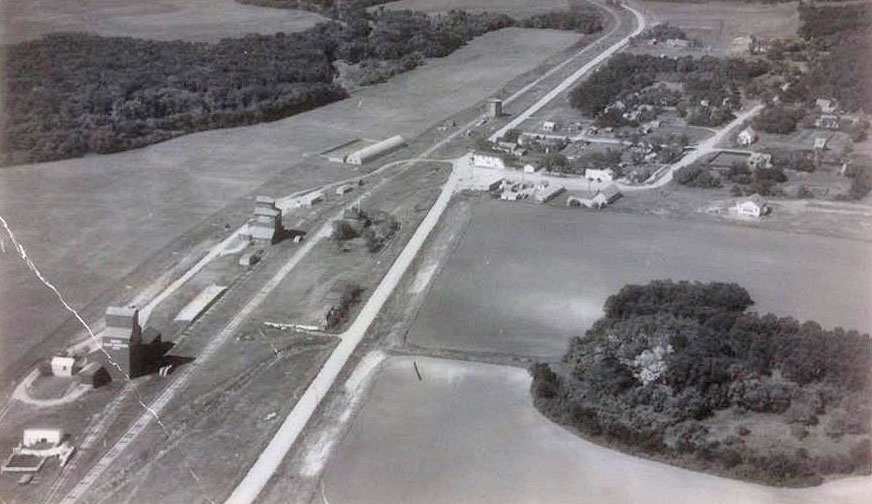
Some of the agents at
Neelin were Mr. Upton, Mr. Bill Easterly, George Richens, Art Skinner,
Bruce McLeish. Some of the foremen were George Giddings, Bill
Huddlestone, Sr., John Trinder, Calvin Angel, Alex Rivist. Some of the
regular men were Mr. Bill Henwood, Enoch Tomlin, Stan Wright, Ben Free.
All mail and perishable goods came by train. The mail was sorted for
in-between stations by mail clerks on the train, so a letter could be
mailed one day and an answer arrive by next day.
Most farmers used to load cars of grain from the loading platform. In
the winter the town would be alive with teams and sleighs bringing the
grain.
The water tank for the steam-engines was located at Neelin and when the
grain trains were running, it was a busy stopping place.
The decline of the railway began when the trucks took over much of the
goods handled by the railway. Grain continued to be shipped by rail
until 1978.
Elevators
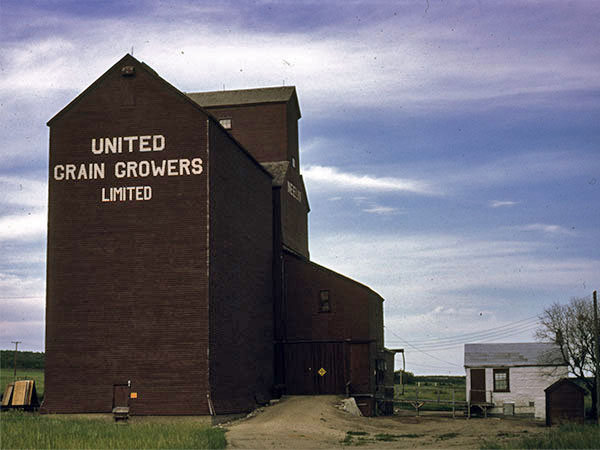
Shortly after the C.N.R. went
through Neelin, the first grain elevator was built, by the Western
Canada Flour Mills Company. Andrew Easton operated it as long as it
remained under that name.
In 1928,
the Grain Growers built a second elevator. Wilbur Ross was the first
operator and Mac Archibald was his successor.
The first
organizational meeting of the Neelin Pool Elevator was held in1940. The
chairman of the first board was F.A. Neelin and the board members were:
J .H. Cooper; J. Lockerby; P.L. McLaren (secretary); H.D. McLaren;
Alfred Neelin; and N. Mabon.
The last
meeting of the Neelin Pool Board was held in 1978. The last board
members were: M. Turner (chairman); R.E. Mabon; J.A. Riglin,
(secretary); D. McGill; C.B. Darling and K.A. Riglin. The last agent in
Neelin was Fred Bowles. The elevator closed in 1978.
The Pool
took over the Western Canada Flour Mills elevator and Mr. Easton
retired. Larry Abery was manager, then Vic Janz. In 1966, Fred Bowles
became operator and the two elevators were competitors. In 1969 or
1970, the Manitoba Pool took over the Grain Growers. Trucking was
taking over the delivery of grain. In 1973, the elevator was closed,
peace and quiet reigned, where there had been such activity, so vital
to the community.
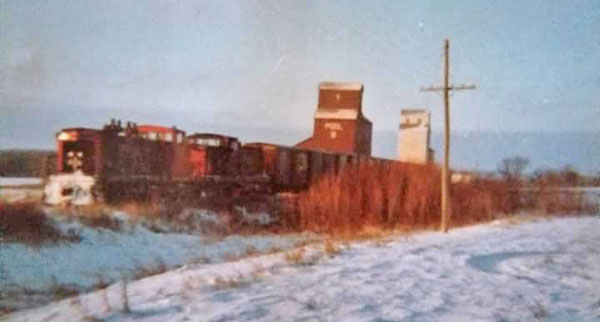
Several of photos, like
these two
by
by Laurie Gilles can be found on the Legends of Neelin Facebook Page
The CN Station
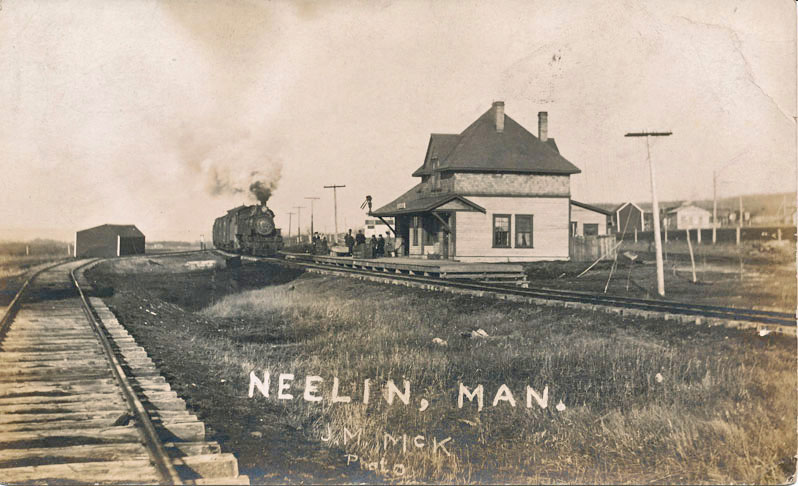
Stuart Hicks was a station agent from 1929 to 1932. Many
cans of cream and crates of eggs made their way to market on the old
CNR Wakopa. The station unfortunately burned on a windy winter day in
1959.
An elevator was built in 1927 with a capacity of 32,000 bushels. The
annex was built in 1952, having a capacity of 45,000 bushels. All
facilities: elevator, annex, house, etc. cost $41,000. (the replacement
value of course would be much higher than this). The living quarters
were at first in the north-west corner of the elevator until a
comfortable bungalow was built about 1943.
Total bushels handled up to July 31,1969 were 5,835,000 bushels.
Following are the agents since the association was formed until its
closure in 1978:
1927-1928 - W. P. Waters; 1929-1950 - C. C. Douglas; 1950-1952 - F. W.
McIntosh; 1953-1958 - D. P. Miller; 1958-1962 - R. N. Denbow; 1962-1973
- W. B. Gordon; 1973-1975 - Denis Magwood; 1975-1978 - Claire Lobreau.
The original directors: Bruce Fraser - President; J. E. Brinkworth -
Vice; J. M. Cruikshank - Secretary; P. T. Cuthbert, Silas Wardell, N.
Galloway, Frank Nelson.
The final directors: Wesley Nelson, Jim Kynoch, John Thomas, Grant
Harrison, Ralph Ballantine, Roger Lebeau, Robert Lundgren.
Much to the disapproval of all area farmers and after many attempts on
their part to persuade the powers that be, to leave us our elevator, it
was closed at the end of 1978. The elevator, annex, coal sheds were
sold to Desrochers farms and the house to Tony and Renee Bisson.
Main Source: Argyle History Book
|